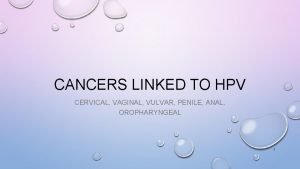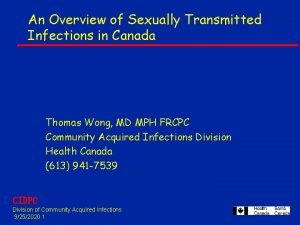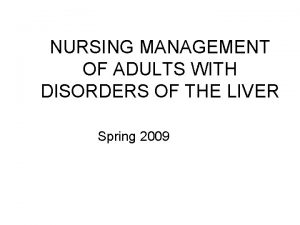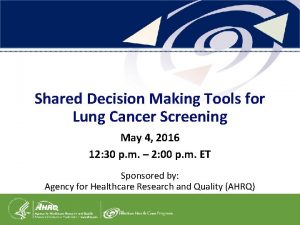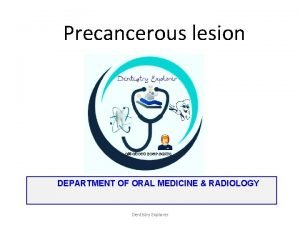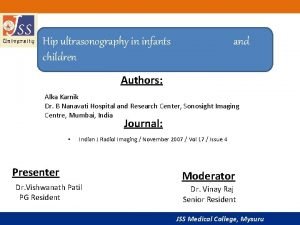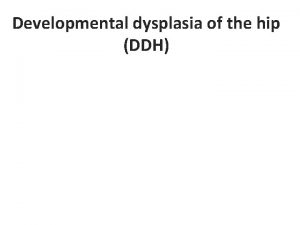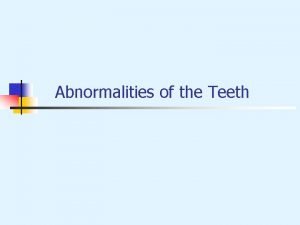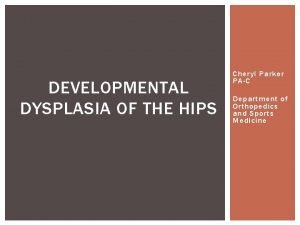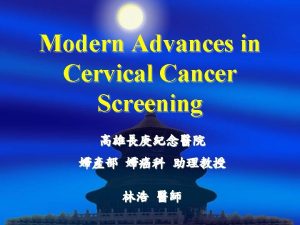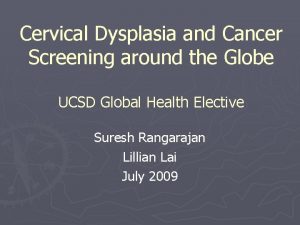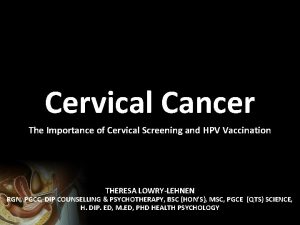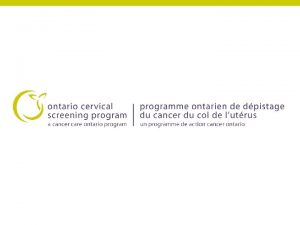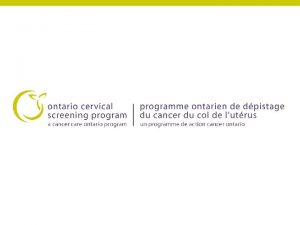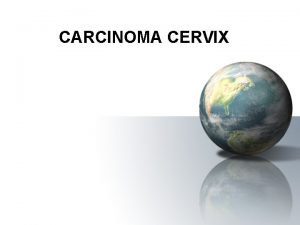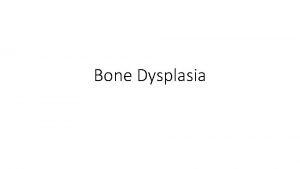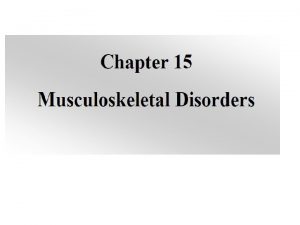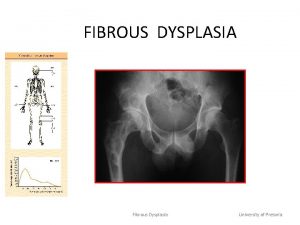Cervical Screening for Dysplasia and Cancer in Patients


















- Slides: 18

Cervical Screening for Dysplasia and Cancer in Patients with HIV www. hivguidelines. org

Purpose of the Guideline § § Increase the numbers of NYS residents with HIV infection who are screened for cervical dysplasia and whose care is managed effectively if cervical dysplasia or cancer are diagnosed. Support the NYSDOH Prevention Agenda 2013 -2018, which aims to increase by 5% the percentage of all females aged 21 to 65 years with an income of <$25, 000 who receive cervical cancer screening. Reduce the incidence of morbidity and mortality associated with cervical cancer in persons living with HIV infection through early identification and treatment of precancerous and cancerous lesions, when treatment is most successful. Integrate current evidence-based clinical recommendations into the healthcarerelated implementation strategies of the Ending the Epidemic (ETE) initiative, which seeks to end the AIDS epidemic in NYS by the end of 2020. Cervical Screening 2/26/19 NYSDOH AIDS Institute Clinical Guidelines Program www. hivguidelines. org

Who to Screen § § § Screening for cervical cancer in the setting of HIV should be performed as detailed in this guideline for eligible individuals, including cisgender women, transgender men, and nonbinary individuals assigned female at birth. Transgender men who have an intact vagina or cervix remain at risk of HPV infection, vaginal or cervical dysplasia, and cervical cancer. Throughout this guideline, the term transgender men refers to individuals assigned female at birth but who identify as male. Approximately one-third of transgender or gender nonconforming individuals who were assigned female at birth identify as neither male nor female (i. e. , nonbinary). This committee encourages care providers to discuss the need for cervical cancer screening with transgender men and nonbinary individuals to help ensure appropriate care for these individuals. Cervical Screening 2/26/19 NYSDOH AIDS Institute Clinical Guidelines Program www. hivguidelines. org

Recommendation: Preventing Cervical Cancer and Precancerous Lesions þ Clinicians should recommend the 9 -valent HPV vaccine three-dose series at 0, 2, and 6 months to all individuals aged 9 to 26 years with HIV regardless of CD 4 cell count, and prior cervical or anal Pap test results, HPV-related cytologic changes, or history of HPV lesions. (A 3) Cervical Screening 2/26/19 NYSDOH AIDS Institute Clinical Guidelines Program www. hivguidelines. org

Rationale for HPV Vaccination § Nearly 100% of cervical cancers are associated with HPV infections. § The 9 -valent HPV vaccine protects against non-oncogenic HPV subtypes 6 and 11 and oncogenic HPV subtypes 16, 18, 31, 33, 45, 52, and 58. § Although the HPV infection subtypes most commonly associated with cervical cancer are HPV 16 and HPV 18 in the general population, in females with HIV, a broader range of HPV oncogenic subtypes are associated with cervical dysplasia. § In females with HIV, the risk of HPV-related cervical disease is greater than in those who do not have HIV, and cervical cancer is the leading cause of cancer death among this population. § HPV vaccination coupled with regular cervical cytologic screening to identify precancerous lesions, treatment, and follow-up is an effective intervention for decreasing the incidence of cervical cancer. Cervical Screening 2/26/19 NYSDOH AIDS Institute Clinical Guidelines Program www. hivguidelines. org

Recommendations: Cervical Pap Tests þ Clinicians should perform a cervical Pap test for all individuals assigned female at birth who have HIV infection at the following time intervals: • Within 2 years of the onset of sexual activity or by age 21 years. (A 2) • Annually until 2 tests in a row screen negative, then every 3 years. (A 2) • At 6 months after treatment for an abnormal result, then annually until 2 tests in a row screen negative, then every 3 years. (A 3) þ Clinicians should perform cervical cytologic screening for individuals who have undergone a supracervical hysterectomy (cervix left in situ). (A 1) þ After total hysterectomy (uterus and cervix removed), clinicians should perform vaginal Pap testing at least annually until results are negative for 2 tests in a row, then every 3 years. (A 2) þ Clinicians should repeat cervical cytologic tests after 2 months but within 4 months after a result of “insufficient specimen for analysis. ” (A 3) þ Clinicians should perform HPV co-testing (cervical cytologic test with a concurrent HPV test) only for individuals who are older than 30 years. (A 2) Cervical Screening 2/26/19 NYSDOH AIDS Institute Clinical Guidelines Program www. hivguidelines. org

Key Points: Routine Screening → Regardless of Pap test results, it is important that routine screening for STIs continues to be performed to assess for risk behaviors that require repeat or ongoing screening. → It is important that clinicians continue to perform visualization of the external anogenitalia and a digital pelvic examination as part of the annual physical examination. Cervical Screening 2/26/19 NYSDOH AIDS Institute Clinical Guidelines Program www. hivguidelines. org

Key Points: Testosterone Use → Because testosterone use can induce vaginal atrophy and affect specimen adequacy for a cervical Pap test, the Pap test requisition for transgender men should note both testosterone use and the presence of amenorrhea to assist the accurate interpretation of cell morphology. → Asking patients about all gender-reassignment and gynecologic surgical procedures is essential to determine the need for cervical or vaginal screening. Cervical Screening 2/26/19 NYSDOH AIDS Institute Clinical Guidelines Program www. hivguidelines. org

Cytological and Histological Classification of Cervical Dysplasia Bethesda Classification System (2014) Describes cytology obtained at cervical Pap Cervical Intraepithelial Lesion (or neoplasia [CIN]) Describes histology obtained at biopsy ASC-US: Atypical squamous cells of undetermined significance Atypia: -- ASC-H: Atypical squamous cells, high-grade squamous intraepithelial lesion (HSIL) cannot be excluded CIN II: Moderate-grade cervical intraepithelial neoplasia; may be a low-grade or high-grade lesion AGC: Atypical glandular cells AGC-NOS: Atypical glandular cells not otherwise specified AGC-FN: Atypical glandular cells favoring neoplasia LSIL: Low-grade squamous intraepithelial lesion CIN I: Low-grade cervical intraepithelial neoplasia CIN III: High-grade cervical intraepithelial neoplasia CIS: Carcinoma in situ Cancer: -- HSIL: High-grade squamous intraepithelial lesion Cancer: -Adapted from Nayer R, Wilbur DC. The Pap test and Bethesda 2014. Cancer Cytopathol 2015; 123(5): 271 -81. Cervical Screening 2/26/19 NYSDOH AIDS Institute Clinical Guidelines Program www. hivguidelines. org

Recommendation: HPV Co-Testing vs. Reflex Testing þ Clinicians should perform HPV co-testing (cervical cytologic test with a concurrent HPV test) only for individuals who are 30 years or older. (A 2) Notes: • HPV co-testing is routinely performed at the same time as a cervical Pap test in individuals >30 years. • HPV reflex testing is performed in response to an abnormal cervical Pap test result in individuals <30 years, and in individuals >30 years who did not receive an HPV co-test at the time of their cervical Pap test. Cervical Screening 2/26/19 NYSDOH AIDS Institute Clinical Guidelines Program www. hivguidelines. org

HPV Co-Testing vs. Reflex Testing HPV co-testing has been found to be a useful adjunct to cervical cytology screening in females with HIV infection who are 30 years or older. • If HPV/cervical cytologic co-testing is performed in an individual with HIV infection and results are positive for high-risk HPV but negative for abnormal cytology, clinicians should consider repeating the Pap test at a shorter time interval and/or colposcopy for further evaluation for abnormal cells that may have been missed on the initial screen. • Females with HIV infection, a normal Pap test, and a positive high-risk HPV test result have 4 times the risk of having an abnormal finding on colposcopy. HPV co-testing is not indicated for individuals younger than 30 years. • Spontaneous clearance of HPV infection and cervical neoplasia often occurs in younger individuals regardless of HIV status. • Aggressive treatment of dysplasia from transient HPV infection may damage the cervix and could be more harmful than beneficial in this age group. Cervical Screening 2/26/19 NYSDOH AIDS Institute Clinical Guidelines Program www. hivguidelines. org

Recommendation: Follow-Up in Patients <30 years þ For individuals <30 years with a Pap test result of atypical squamous cells of ASC-US, clinicians should ensure that a reflex HPV test is performed. (A reflex HPV test is performed in response to, not concurrent with, an abnormal Pap test. ) • If the reflex HPV test result is positive, clinicians should refer the patient for colposcopy. (A 2) • If the reflex HPV test is negative, clinicians should perform both a repeat Pap test and an HPV test at 1 year. (A 2) § If both tests are negative at 1 year, then the clinician should resume standard Pap testing (every 3 years). (A 2) Cervical Screening 2/26/19 NYSDOH AIDS Institute Clinical Guidelines Program www. hivguidelines. org

Recommendation: Follow-Up in Patients >30 years þ For individuals >30 years, an HPV co-test is routinely performed along with a cervical Pap test; however, if the HPV co-test was not performed in a patient who has a Pap test result of ASC-US, then clinicians should perform HPV reflex testing. • If the HPV test result is positive, clinicians should refer the patient for colposcopy. (A 2) • If the HPV test result is negative, clinicians should perform both a repeat Pap test and an HPV test at 1 year: § If either test result is positive, clinicians should refer the patient for colposcopy. (A 2) § If both test results are negative, then the clinician should resume standard Pap testing (every 3 years). (A 2) Cervical Screening 2/26/19 NYSDOH AIDS Institute Clinical Guidelines Program www. hivguidelines. org

Recommendations: Follow-Up in All Patients þ For individuals of all ages, clinicians should refer for or perform colposcopy in response to the following cervical Pap test results: • Atypical squamous cells, HSIL cannot be excluded [ASC-H]. (A 1) • Low-grade squamous intraepithelial lesion [LSIL]. (A 1) • High-grade squamous intraepithelial lesion [HSIL]. (A 1) • Any result of atypical glandular cells [AGC]. (A 1) þ Colposcopy is not indicated as an initial screening test. Clinicians should limit colposcopy for use as a follow-up to abnormal screening on either Pap test or high-risk HPV test. (A 2) þ After a patient has completed treatment for an abnormal cervical biopsy test, clinicians should repeat cytologic tests at 6 months, then annually until 2 tests in a row screen negative, then every 3 years. (A 3) Cervical Screening 2/26/19 NYSDOH AIDS Institute Clinical Guidelines Program www. hivguidelines. org

Cervical Screening 2/26/19 NYSDOH AIDS Institute Clinical Guidelines Program www. hivguidelines. org

Recommendations: Diagnosed Cervical Cancer þ Clinicians should immediately refer patients with HIV infection and a diagnosis of cervical cancer to a gynecologic oncologist or surgeon trained in the management of cervical cancer. (A 2) þ Clinicians should closely monitor patients with cervical cancer in close collaboration with the gynecologic oncologist after definitive treatment for cancer. (A 3) Key Point: → The standard therapeutic approach to treating cervical cancer in individuals with HIV is the same as that for those who do not have HIV; however, the increased risk of treatment failure and high recurrence rate warrant close follow-up by a multidisciplinary team of clinicians even after definitive treatment for cervical cancer. Cervical Screening 2/26/19 NYSDOH AIDS Institute Clinical Guidelines Program www. hivguidelines. org

Need Help? What to Start 2/26/19 NYSDOH AIDS Institute Clinical Guidelines Program www. hivguidelines. org

Access the Guideline § www. hivguidelines. org > Primary HIV Care > Cervical Screening for Dysplasia and Cancer § Also available: Printable pocket guide; printable PDF 3/2/2021 NYSDOH AIDS Institute Clinical Guidelines Program
 National breast and cervical cancer early detection program
National breast and cervical cancer early detection program National breast and cervical cancer early detection program
National breast and cervical cancer early detection program Slyngexcision
Slyngexcision Stage 4 cervical cancer
Stage 4 cervical cancer Hpv cervical cancer
Hpv cervical cancer Hpv cervical cancer
Hpv cervical cancer Cervical cancer hcp
Cervical cancer hcp Nursing care plan of cancer patients ppt
Nursing care plan of cancer patients ppt Lung cancer screening shared decision making tool
Lung cancer screening shared decision making tool Hip and elbow dysplasia
Hip and elbow dysplasia Epithelial dysplasia
Epithelial dysplasia Cleidocranial dysplasia
Cleidocranial dysplasia Infant hip
Infant hip Ground glass appearance fibrous dysplasia
Ground glass appearance fibrous dysplasia Ddh définition
Ddh définition Cleidocranial dysplasia
Cleidocranial dysplasia Dog kidney
Dog kidney Akondroplazi
Akondroplazi Barlow ortolani test
Barlow ortolani test




